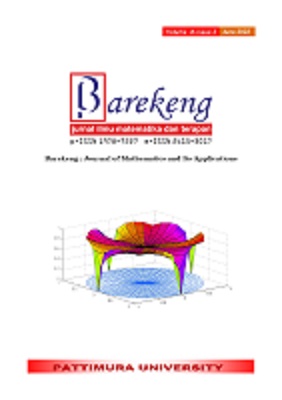ON ANTIADJACENCY MATRIX OF A DIGRAPH WITH DIRECTED DIGON(S)
Abstract
The antiadjacency matrix is one representation matrix of a digraph. In this paper, we find the determinant and the characteristic polynomial of the antiadjacency matrix of a digraph with directed digon(s). The digraph that we will discuss is a digraph obtained by adding arc(s) in an arborescence path digraph such that it contained directed digon(s), and a digraph obtained by deleting arc(s) in a complete star digraph. We found that the determinant and the coefficient of the characteristic polynomial of the antiadjacency matrix of a digraph obtained by adding arc(s) in an arborescence path digraph such that it contained directed digon(s) is different depending on the location of the directed digon. Meanwhile, the determinant of the antiadjacency matrix of a digraph obtained by deleting arc(s) in the complete star digraph is zero.
Downloads
References
A. A. Kikelomo, Y. N. Asafe, A. Paul, and L. N. Olawale, "Design and implementation of mobile map application for finding shortest direction between two pair locations using shortest path algorithm: a case study," International Journal of Advanced Networking and Applications, vol. 9, no. 1, p. 3300, 2017.
X. Bai, W. Yan, and M. Cao, "Clustering-based algorithms for multivehicle task assignment in a time-invariant drift field," IEEE Robotics and Automation Letters, vol. 2, no. 4, pp. 2166-2173, 2017.
R. B. Bapat, Graphs and matrices. London: Springer, 2010.
Wildan, "Polinomial Karakteristik Matriks Antiadjacency dan Adjacency dari Graf Berarah Yang Diberi Orientasi," Master Degree, Departemen Matematika, Universitas Indonesia, Depok, 2015.
F. Firmansah, "Polinomial Karakteristik Matriks Antiadjacency Dari Graf Berarah Yang Asiklik," Master Degree, Departemen Matematika, Universitas Indonesia, Depok, 2014.
C. Zhang, Y. Wu, W. Liu, and X. Yang, "Fixation probabilities on complete star and bipartite digraphs," Discrete Dynamics in Nature and Society, vol. 2012, 2012.
B. Voorhees, "Birth-Death Models of Information Spread in Structured Populations," in ISCS 2014: Interdisciplinary Symposium on Complex Systems, 2015: Springer, pp. 67-76.
B. Voorhees and B. Ryder, "Simple graph models of information spread in finite populations," Royal Society open science, vol. 2, no. 5, p. 150028, 2015.
C. D. Meyer, Matrix analysis and applied linear algebra. Siam, 2000.
J. A. Bondy and U. S. R. Murty, "Graph Theory, volume 244 of," Graduate texts in Mathematics, vol. 623, 2008.
G. Chartrand, L. Lesniak, and P. Zhang, Graphs & digraphs. CRC press, 2010.
G. Chartrand and P. Zhang, A first course in graph theory. Courier Corporation, 2013.
G. Chartrand and P. Zhang, Chromatic graph theory. CRC press, 2019.
N. Deo, Graph Theory With Applications to Engineering and Computer Science. Courier Dover Publications, 2017.
G. Gordon and E. McMahon, "A greedoid polynomial which distinguishes rooted arborescences," Proceedings of the American Mathematical Society, vol. 107, no. 2, pp. 287-298, 1989.
Authors who publish with this Journal agree to the following terms:
- Author retain copyright and grant the journal right of first publication with the work simultaneously licensed under a creative commons attribution license that allow others to share the work within an acknowledgement of the work’s authorship and initial publication of this journal.
- Authors are able to enter into separate, additional contractual arrangement for the non-exclusive distribution of the journal’s published version of the work (e.g. acknowledgement of its initial publication in this journal).
- Authors are permitted and encouraged to post their work online (e.g. in institutional repositories or on their websites) prior to and during the submission process, as it can lead to productive exchanges, as well as earlier and greater citation of published works.






1.gif)



